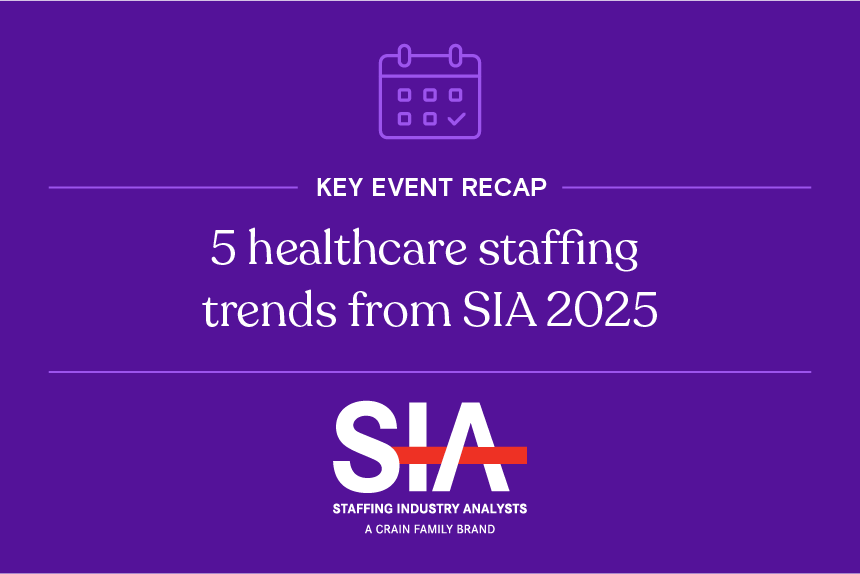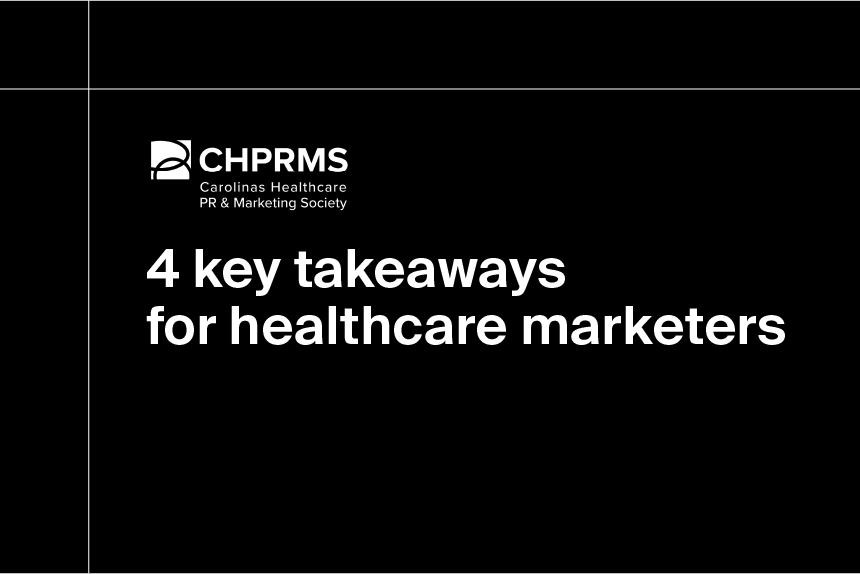The 2025 Staffing Industry Analyst Healthcare Staffing Summit brought together healthcare staffing leaders to discuss industry challenges and innovations. In this blog, we cover the top five trends dominating the Summit’s sessions and exhibition hall conversations.
–
Last year, the Staffing Industry Analyst (SIA) Healthcare Staffing Summit delivered a clear—if mixed—message: healthcare staffing is in a period of accelerated transformation, for better and for worse. SIA 2025 left us feeling similarly hopeful and hesitant.
The healthcare staffing market is growing, new and innovative technologies are rising to meet ongoing challenges in recruitment and retention… and yet it sure seems like those challenges aren’t going away. So, in an increasingly tumultuous healthcare landscape, what’s the move for 2026?
Whether you’re directly involved in provider staffing or you provide support for organizations that are, the formal sessions and casual discussions hosted at this year’s SIA Healthcare Staffing Summit offer some directional guidance on strategy for the year ahead. Here are the biggest takeaways you should know about:
1. Locum tenens is booming
One of the most talked-about staffing trends at this year’s summit was the continued surge in locum tenens demand. Even as healthcare systems work toward rebuilding permanent physician teams, locum continues to expand as a strategic pillar rather than a temporary fix.
A study by CHG Healthcare, the largest locum tenens staffing organization in the U.S., found that locum usage in 2024 hit 81%, up from forecasted projections of 56%. For health systems, these temporary staffers are an increasingly core component of workforce planning.
Not only do locum tenens staff enable providers to buffer against unpredictable patient volumes and peaking utilization; they also help cover growing gaps in care teams caused by slow hiring, sudden departures, maternity or paternity leave, and vacation leave. In areas where specialists are in short supply—such as many rural regions—locum staff serve an especially critical role.
With the CHG Healthcare study showing 80% of facilities planned to maintain or increase locum usage this year, we’ll be keeping a close eye on this trend in 2026.
2. Physician burnout continues to smolder
Burnout continues to drive—and be driven by—workforce shortages, so it’s not surprising that stressed-out physicians dominated conversations at SIA’s Healthcare Staffing Summit again this year.
While data suggests physician burnout has fallen from its all-time peak, it remains at historically high levels. Some of the key contributors discussed include:
- Administrative burden and EHR fatigue
- Escalating patient loads
- Shift instability and lack of schedule autonomy
- Growing pressure to ‘do more with less’
As physicians increasingly depart full-time roles and reduce their clinical hours, health systems and practices face a widening supply-demand imbalance that’s boosting salaries, stretching out recruiting timelines, and fueling reliance on locum tenens and other alternative staffing models.
A combination of data science and artificial intelligence (AI) could help providers and staffing firms preempt labor shortages and demand spikes based on factors like physician age and specialty, as well as patient health attributes like disease state and recent care episodes. The staffing pros at AMN Healthcare shared their own predictive model that uses physician age, tenure, and caseload to anticipate physician retirements with an 83% success rate.
3. Recruitment timelines are growing
Want to hire a doctor? Better start planning a year in advance. One of the more eye-opening data points presented at SIA 2025 was that it now takes roughly 300 days to fill a permanent physician role. And to complicate matters further, an outsized portion of physicians are poised to retire in the near future.
For providers and staffing firms, this means recruiting pipelines need to be deeper—and more thoroughly engaged—than ever. For providers specifically, retention is now more than a cost-savings strategy; it’s a significant competitive differentiator.
And because credentialing can represent up to half of the hiring timeline, some organizations are turning to AI to automate, streamline, and ultimately reduce errors within those workflows.
The growing recruitment timeline also highlights a need for sophisticated forecasting models that not only consider labor supply and patient demand but also predict the timing of various phases of the recruitment process.
Drawing from a wide variety of data sources, including diagnostic and procedural all-payor claims, reference and affiliations data, consumer behavior, and health attributes, it’s possible to anticipate periods of heightened demand within specific markets, populations, and therapy areas. With these insights, hiring organizations can then coordinate recruiting campaigns well in advance and tailor engagement strategies to more specific and relevant audiences.
4. AI supports both sides of the staffing problem
AI was a headline topic at nearly every convention and trade show we attended this year. Just as this transformative tech is demonstrating utility for strained provider teams and underfunded life science develops, it’s not hard to see its practical applications in healthcare staffing.
In a high-touch industry like healthcare, AI isn’t a substitute for genuine connection; ideally, it’s a tool to enable recruiters to spend less time on admin work and more time in front of candidates. In these cases, AI can serve as a force multiplier, reducing the time and attention needed on routine tasks like:
- Candidate sourcing
- Lead scoring and prioritization
- Resume screening
- Medical credentialing
- Omnichannel engagement sequences
Generally speaking, the more relationship-driven the task, the more human oversight should be implemented (although human-led audits should be conducted periodically even at the earliest stages of screening and sourcing to ensure potential biases within automated tools don’t inadvertently filter out highly qualified candidates).
For example, once candidates are squarely within the recruiting workflow, upping the number of human interactions can go a long way in cementing trust and reducing dropout rates. Likewise, staffing firms will find that most provider clients respond positively to legitimate relationship-building rather than automated email or SMS blasts.
5. Data integration is enhancing workflows across the industry
Multiple sessions and conversations we encountered at SIA 2025 highlighted the value of data for recruitment, retention, and a variety of other critical workflows.
High-quality, thoroughly cleansed data can make it easier to understand the needs of specific patient populations or the providers that serve them, then find, engage, and assess the suitability of candidates to meet those needs.
The most useful datasets tend to be a blend of publicly available information (like claims and contact data), market-level commercial intelligence, and proprietary insights gathered from prospect and candidate conversations, EHRs, and other internal sources. We learned that some companies are even using AI to automatically turn these internal data sources into useful insights.
Gathering all this data isn’t easy. Refining it, keeping it up to date, and integrating these myriad sources into real-world workflows is considerably harder, even for organizations with in-house AI or robust IT teams.
That’s where a reliable data vendor can help save time, money, and sanity. Definitive Healthcare offers solutions for staffing organizations as well as provider networks and practices looking to attract and retain top talent.
Whether you’re seeking candidates with specific certifications, therapeutic focuses, or technological expertise, our data can help you find them with minimal additional work on your end. However and wherever your team works, our data seamlessly integrates into your workflows, so you’re always aligned around a central source of truth.
See it for yourself: Sign up for a demo today.




